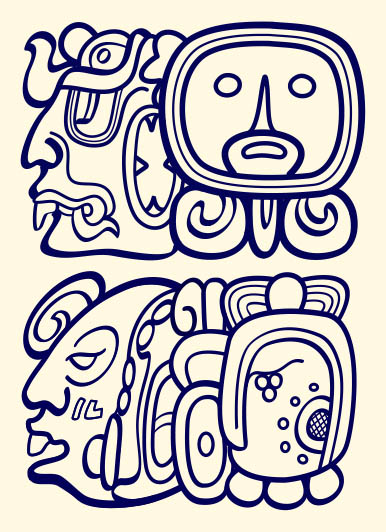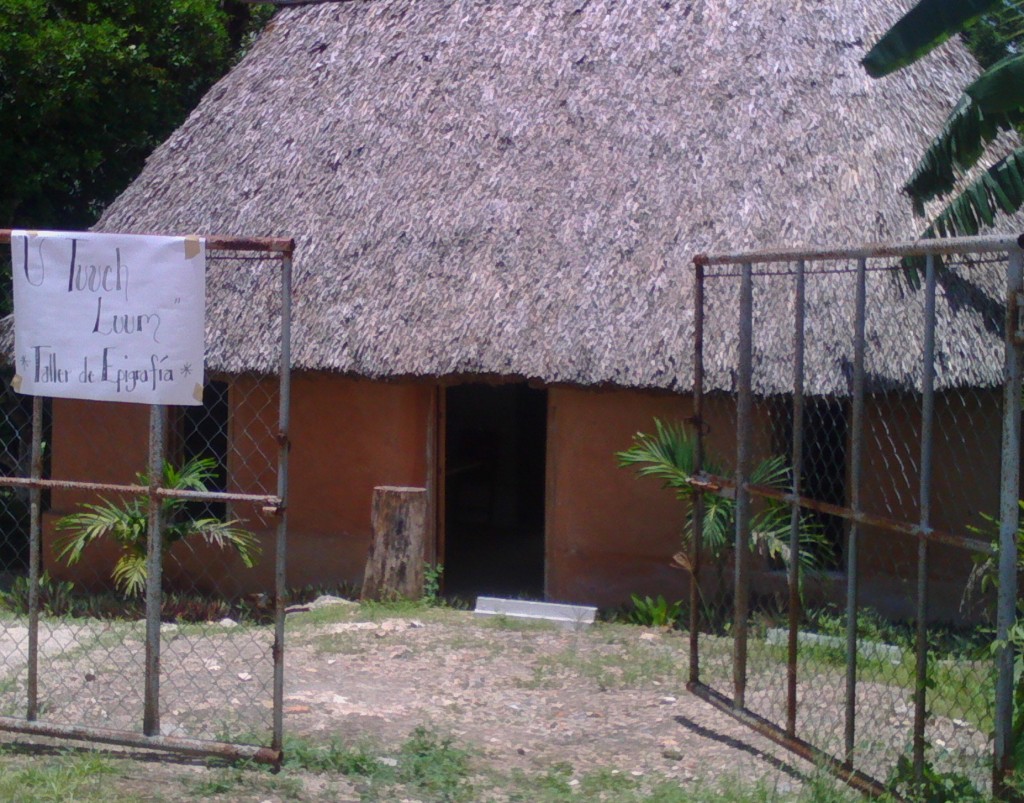Maní Workshop: Ts’íib (“Writing”)
by Jiménez Balan Iván de Jesús
Young people from the community of Maní were invited to participate in an epigraphy workshop. The place: U Tuch Lu’um (“naval of the land”), Maní, Yucatan.
Beginning 2 Ix 2 Xul – Ending 6 Etz’nab 6 Xul
(July 13-17, 2015)
This workshop aimed to raise awareness among young people to learn the wisdom of our grandparents, knowing the Maya syllabary, learning about ancient writing, and providing basic tools to start writing and reading ancient inscriptions.
Taller Maní: Ts’íib (“Escritura”)
por Jiménez Balan Iván de Jesús
Se convocó a jóvenes de la comunidad de Maní, para participar en un taller de epigrafía. El lugar: U tuch lu’um (“ombligo de la tierra”), Maní, Yucatan.
Iniciamos el 2 Ix 2 Xul – Terminamos el 6 Etz’nab’ 6 Xul
(13-17 de julio del 2015)
Este taller tuvo como objetivo sensibilizar a los jóvenes a conocer la sabiduría de nuestros abuelos y abuelas, conocer el silabario maya, aprender la forma de escritura antigua y proporcionando las herramientas básicas para empezar a escribir y leer las antiguas inscripciones.
The first day began with the introduction of each participant, giving their name and school. They were provided the material used in the workshop (folder with syllabary, sheets of paper, pencils, pens, and notepad), and they were thanked for their presence in the Ts’iib workshop.
The first three days, students were introduced to some of the history of the glyphs, as well as syllables and logograms with their meanings. They were given the syllabary to write their personal names.
Later we analyzed some examples of how you can write some titles, like saying who is the father, the mother, and the place from where they come. Exercises are done and analyzed, and some questions are cleared up.
As an exercise, each student began to make his own stela with information already learned, so that in the end they could make a small stela of their own lineage.
Information was provided on Maya numbers, the Maya calendar tzol k’iin, and analysis of each of the elements they contain and their relationship with each other, as well as with the Maya calendar ha’ab.
They explained how the structure of a stela is read and what is the ISIG (Initial Series Introductory Glyph). The group learned to identify the glyph for birth, the ISIG, and Maya numbers to add to their lineage stela.
The inscriptions on the steps of the acropolis of Ek Balam and the transliteration of it were projected in the class to analyze (reference: FAMSI © 2003: Alfonso Garcia-Gallo Lacadena Glyph Corpus of Ek ‘Balam, Yucatan, Mexico), and the necessary information was provided for the tour to be made to the archaeological site of Ek Balam.
On Sunday the 16th, we traveled to the site of Ek Balam, a Mayan archaeological site in Yucatan, Mexico. It is located 30 km north of the city of Valladolid, 2 km from the Maya village of Ek Balam. In Mayan, éek’ báalam means “black jaguar” (éek’ “black,” báalam “jaguar”).
The arrival in Ek Balam was at about 10 am, where we met with the group from Tipikal, accompanied by our colleague Daniela Cano. We took in everything that was possible to observe, identifying Mayan glyphs that this city had to offer. The group was able to identify syllables of stelae in the plaza, and glyphs on the steps of the acropolis. On the 17th, there was feedback on what they learned in the workshop and experienced at the archaeological site of Ek Balam.
The workshop ended with the presentation of awards in our new space Epigrafía Utuch Lu’um, but not before thanking the principal of U Yits Ka’an school, Atilano Loeza Ceballos, for allowing us to hold the workshop and for providing this space for us, and to the directors of MAM for their support.
Comments by the participants:
“All that we experienced was fun, because we learned a lot about writing of the ancient Maya, and I promise to continue studying all about Maya epigraphy.” -Pilar Poot
“The workshop was very interesting, I learned to write my name in syllables and the names of my mom and dad. I would like to learn more about ancient writing.” -Sugeimi
“It was a unique experience for us to participate in this workshop. It was very rewarding, thanks to everyone who made it possible.” -Roseli
“To know the ancient Maya writing was very nice, I have always seen these pictures but did not know how to read them, now I can understand a little more about my culture. Thank you!” -Aline
¡Nib ‘ oolal!
¡Gracias!
El primer día se inicia con la presentación de cada participante, ellos mencionaron su nombre y escolaridad. Se les proporcionó el material a utilizar en el taller (carpeta con el silabario, hojas, lápices, plumas y libreta). De antemano se les agradece su precencia a este taller Ts’íib.
Los primeros tres días, conocimos un poco de la historia de los glifos, y conocimos las silabas y los logogramas con sus significados. Se les proporcionó el silabario para poder escribir el nombre personal.
Después analizamos algunos ejemplos sobre cómo se puede escribir algunos oficios, como decir quién es el padre y la madre y del lugar de donde provienen. Se hacen algunos ejercicios, se analizan, y se despejaron algunas dudas.
Se les deja como ejercicio que cada alumno empiece a realizar su propia estela con la información antes ya analizada, de manera que al final construyan una pequeña estela de su linaje.
Se facilitó la información de los números Mayas, el calendario Maya tzol k´iin y el análisis de cada uno de los elementos que contiene y su relación con el calendario Maya del ha´ab.
Se les explicó la estructura del cómo se lee una estela y lo que es el G.I.S.I. (Glifo Introductorio de la Serie Inicial). El grupo aprendió a identificar el glifo de nacimiento, el G.I.S.I., y los números mayas para anexarlos a su estela de linaje.
Se proyectaron las inscripciones de la escalinata de la acrópolis de Ek Balam y la transliteración de la misma para analizar (referencia: FAMSI © 2003: Alfonso Lacadena García-Gallo El Corpus Glífico de Ek’ Balam, Yucatán, México), y se proporcionó la información necesaria sobre el recorrido que se hará en la Zona Arqueológica de Ek Balam.
El domingo 16, nos trasladamos en la zona arqueológica de Ek Balam, un sitio arqueológico maya en Yucatán, México. Está localizado a 30 km al norte de la ciudad de Valladolid, a 2 km del poblado Maya de Ek Balam. En maya yucateco, éek’ báalam significa “jaguar negro” (éek’ “negro”, báalam “jaguar”).
La llegada en Ek Balam fue a aproximadamente a las 10 am, donde nos encontramos con el grupo de Tipikal, acompañados por la compañera Daniela Cano. Aprovechamos todo lo que se pudo para observar, identificar los glifos que esta ciudad maya nos proporcionaba.
El grupo pudo identificar sílabas de las estelas en la plaza y textos situados en las escaleras de la acrópolis. El día 17, se hizo una retroalimentación sobre todo lo aprendido en el taller y lo vivido en la zona arqueológica de Ek Balam.
Terminamos este taller con la entrega de reconocimientos en nuestro nuevo espacio de Epigrafía Utuch Lu’um, no sin antes dar las gracias al director de la escuela U Yits Ká’an, Atilano Ceballos Loeza, por permitirnos realizar el taller y por facilitarnos este espacio, y a los directivos de MAM por su apoyo.
Comentarios de los participantes:
“Fue muy divertido todo lo que vivimos, por que aprendimos muchas cosas de la escritura de los antiguos mayas, y me comprometo a seguir estudiando todo sobre epigrafía maya.” -Pilar Poot
“El taller fue muy interesante, aprendí a escribir en silabas mi nombre y los nombres de mi papá y mamá. Quisiera aprender más de la escritura antigua.” -Sugeimi
“Fue una experiencia única para nosotros participar en este taller, fue muy gratificante, gracias a todos los que lo hicieron posible.” -Roseli
“Conocer la escritura maya antigua, fue muy lindo, siempre veía esos dibujos pero no sabía cómo leerlas, ahora puedo entender un poco más sobre mi cultura. ¡Gracias!” -Aline
¡Nib ‘ oolal!
¡Gracias!









